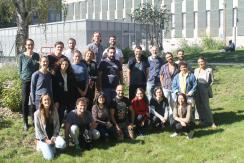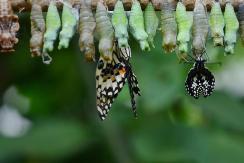COEVOL Multi-Scale Coevolution
Living systems are highly integrated, with a multitude of levels of organization, from molecular and intra-cellular scales to ecosystems. Complex organisms are themselves consortia of macro- and micro-organisms, which work together with their host to build the individual. Yet, each of these organisms can function and evolve in the short term according to its own logic, possibly in conflict with other higher or lower levels, or with other time scales. The once common idea among evolutionists that natural selection results in organisms perfectly adapted to their environment is now severely undermined. Not only because, as the Red Queen explains to Alice, one has to run relentlessly to keep its place in a changing environment, or because past evolutionary history and chance constrain the possibilities of present adaptation, but also because different levels of selection have interests that are generally difficult to reconcile.
Multi-scale coevolution resets classical questions in evolutionary biology
One example, of particular interest is the question of the source of heritable variations. The phenotype of organisms in a population is influenced not only by variations in their nuclear and mitochondrial genomes, the dynamics of which is the object of population genetics, but also more and more patently by the consortium of microbes and genetic elements that constitute its microbiome and virome. The hologenome designates this complex assembly of genetic materials, which obey different rules of transmission and different evolutionary strategies. The ability of symbionts to manipulate host phenotypes or to interfere with each other influences the evolutionary dynamics of all players in ways that are yet poorly understood. In addition, new questions arise, such as the importance of co-adaptation in these systems and their consequences in maintaining cohesive biological systems.
- Symbiosis: a response to and a source of divergent selection
Using a variety of approaches combining experimental evolution, genomic, functional, phenotypic and behavioral data, we aim to test whether symbiosis facilitates diversification and to characterize the underlying microevolutionary processes.
- Ecological networks of horizontal gene transfer
We develop original methods to detect gene transfer and we investigate the factors that influence the routes of gene transfers among microbes but also among insects.
- The interplay between symbiosis, infection and immunity and its evolutionary consequences
We try to understand the intimate interaction of hosts with pathogens, symbionts and transposable elements and how it affects the extended phenotype of the host.
- Transgenerational inheritance and environment changes
We try to decipher the molecular mechanisms that underlie rapid adaptation to environment and to test for transgenerational inheritance of fitness traits.
- Intragenomic conflicts and demography
We are developing models to test whether changes in the demography of the host affect the dynamics of transposable elements.
- The determinism of phenotypic convergence
We study the genomic basis of convergent phenotypic evolution in particular in the case of animals and plants adaptation to increasing temperature and decreasing water.
- Reconciling the tree of life
We develop phylogenetic methods for “reconciling” gene/species or host/symbiont histories and use these methods to explore the bulk of extinct or undescribed species and the history of association of symbiotic microbes with their hosts.
Integrating methods
The methods we use to tackle the questions raised by multi-scale co-evolution extend from theory, modelling and simulation to big data analysis, lab (notably on insects), and to a lesser extent, field activities.
Implication of research, responsibility of researchers and citizen sciences
From our research (some of which have immediate consequences in health, agriculture and ecology) and our concerns about the responsibility of scientists in society, we are committed to promote an “implicative” research. The implicative position means that we try to work on the link between science and society, not only through a one-way communication, applying or explaining our science, but also favoring early discussions on research projects, that may influence our research directions.
Publications
Display of 481 to 510 publications on 710 in total
Yeast ancestral genome reconstructions: the possibilities of computational methods II.
Journal of Computational Biology . 17 ( 9 ) : 1097-112
Journal article
see the publicationPalaeogenomics of plants: synteny-based modelling of extinct ancestors.
Trends in Plant Science . 15 ( 9 ) : 479-87
Journal article
see the publicationComparative genomics : international workshop, RECOMB-CG 2010, Ottawa, Canada, October 9-11, 2010 : proceedings
International Workshop on Comparative Genomics . 978-3-642-16180-3
Le génome aux ordres des mathématiciens
La Recherche . 439 : 54-56
Journal article
see the publicationDo variable compensatory mechanisms explain the polymorphism of the dependence phenotype in the Asobara tabida-wolbachia association?
Evolution - International Journal of Organic Evolution . 64 ( 10 ) : 2969-79
Journal article
see the publicationGenes devoid of full-length transposable element insertions are involved in development and in the regulation of transcription in human and closely related species.
Journal of Molecular Evolution . 71 ( 3 ) : 180-91
Journal article
see the publicationPrevalence of a virus inducing behavioural manipulation near species range border
Molecular Ecology . 19 ( 14 ) : 2995-3007
Journal article
see the publicationThe transmission efficiency of tomato yellow leaf curl virus by the whitefly Bemisia tabaci is correlated with the presence of a specific symbiotic bacterium species.
Journal of Virology . 84 ( 18 ) : 9310-7
DOI: 10.1128/JVI.00423-10
Journal article
see the publicationEndosymbiont metacommunities, mtDNA diversity and the evolution of the Bemisia tabaci (Hemiptera: Aleyrodidae) species complex.
Molecular Ecology . 19 ( 19 ) : 4365-4378
Journal article
see the publicationÉvolution des interactions entre espèces
Biologie évolutive . : 533-616
Book chapter
see the publicationIntragenomic conflict in populations infected by Parthenogenesis Inducing Wolbachia ends with irreversible loss of sexual reproduction.
BMC Evolutionary Biology . 10 : 229
Journal article
see the publicationThe origin of eukaryotes and their relationship with the Archaea: are we at a phylogenomic impasse?
Nature Reviews Microbiology . 8 ( 10 ) : 743-753
DOI: 10.1038/nrmicro2426
Journal article
see the publicationCassis: detection of genomic rearrangement breakpoints.
Bioinformatics . 26 ( 15 ) : 1897-8
Journal article
see the publicationRECOMB Satellite Workshop on Comparative Genomics
8. Annual RECOMB Satellite Workshop on Comparative Genomics . 978-3-642-16181-0 : 303
Jumping genes and epigenetics: Towards new species.
Gene . 454 ( 1-2 ) : 1-7
Journal article
see the publicationGuided genome halving: provably optimal solutions provide good insights into the preduplication ancestral genome of Saccharomyces cerevisiae.
Pacific Symposium on Biocomputing . 15 : 21-30
Conference paper
see the publicationTheory and examples of reciprocal influence between hosts and pathogens, from short-term to long term interactions: coevolution, cospeciation and pathogen speciation following host shifts
Host-Pathogen Interactions: Genetics, Immunology, and Physiology . 978-1608762866
Book chapter
see the publicationComputing the likelihood of sequence segmentation under Markov modelling
Preprint
see the publicationEvolution and manipulation of parasitoid eggload
Evolution - International Journal of Organic Evolution . 63 ( 11 ) : 2974-2984
Journal article
see the publicationA new case of Wolbachia dependence in the genus Asobara: evidence for parthenogenesis induction in Asobara japonica
Heredity . 103 ( 3 ) : 248-256
DOI: 10.1038/hdy.2009.63
Journal article
see the publicationMolecular detection and identification of Rickettsia endosymbiont in different biotypes of Bemisia tabaci
Clinical Microbiology and Infection . -- : 1-2
Journal article
see the publicationA Mixture Model and a Hidden Markov Model to Simultaneously Detect Recombination Breakpoints and Reconstruct Phylogenies
Evolutionary Bioinformatics . 5 : 67-79
DOI: 10.4137/EBO.S2242
Journal article
see the publicationGenomes as documents of evolutionary history
Trends in Ecology & Evolution . 1192 : 1-9
Journal article
see the publicationIdentification of a polymorphic collagen-like protein in the crustacean bacteria Pasteuria ramosa
Research in Microbiology . 160 : 792-799
Journal article
see the publicationGenomic environment influences the dynamics of the tirant LTR retrotransposon in Drosophila
FASEB Journal . 23 : 54-62
Journal article
see the publicationInfra- and Transspecific Clues to Understanding the Dynamics of Transposable Elements
genome dyn stab . -- : 115-123
Journal article
see the publicationComplete genome of the cellulolytic thermophile Acidothermus cellulolyticus 11B provides insights into its ecophysiological and evolutionary adaptations
Genome Research . ( 19 ) : 1033-1043
Journal article
see the publicationFootprints of Inversions at Present and Past Pseudoautosomal Boundaries in Human Sex Chromosomes
Genome Biology and Evolution . 1(1) : 56-66
Journal article
see the publicationAnalysis of fine-scale mammalian evolutionary breakpoints provides new insight into their relation to genome organisation
BMC Genomics . 10 ( 1 ) : 335
Journal article
see the publication

